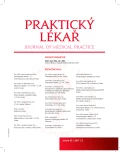-
Medical journals
- Career
Modern technology and its application in home-based rehabilitation
Authors: M. Zádrapová 1,2; E. Mrázková 1
Authors‘ workplace: Ostravská univerzita Lékařská fakulta Ústav epidemiologie a ochrany veřejného zdraví Přednosta: prof. MUDr. Vladimír Janout, CSc. 1; Fakultní nemocnice Ostrava Klinika léčebné rehabilitace Přednostka: MUDr. Irina Chmelová, Ph. D., MBA 2
Published in: Prakt. Lék. 2017; 97(5): 202-205
Category: Reviews
Overview
This article describes benefits and indications of balance therapy. It presents home-based rehabilitation and discusses both its advantages and disadvantages, seen in the perspective of possibilities and limitations of the method, psychology, technic and cost effectiveness. The primary goal is to provide the roundup of available therapeutic devices that use principles of biofeedback. The biofeedback enhances the therapy thanks to the addition of several sensoric stimuli, thus providing better control of the training and improving motivation. There is a wide variety of therapeutic devices and their distinguishing criteria are the number of the sensoric stimuli, user friendliness, level of the applied technology and the price. The article deals equally with the medical devices for health care professionals and the over-the-counter devices, such as those using virtual reality games.
Keywords:
biofeedback – balance therapy – postural correction – home-based rehabilitation
Sources
1. Afzal MR, Oh MK, Choi HY, Yoon J. A novel balance training system using multimodal biofeedback. Biomed Eng Online 2016; 15 : 42. Dostupný z: https://www.ncbi.nlm.nih.gov/pmc/articles/PMC4840978/ [cit. 2017-08-22].
2. Bechly KE, Carender WJ, Myles JD, Sienko KH. Determining the preferred modality for real-time biofeedback during balance training. Gait Posture 2013; 37(3): 391–396.
3. van Diest M, Lamoth CJC, Stegenga J, et al. Exergaming for balance training of elderly: state of the art and future developments. J Neuroeng Rehabil 2013; 10 : 101.
4. van Diest M, Stegenga J, Wörtche HJ, et al. Exergames for unsupervised balance training at home: a pilot study in healthy older adults. Gait Posture 2016; 44 : 161–167.
5. Gatika-Rojas V, Méndez-Rebolledo G. Virtual reality interface devices in the reorganization of neural networks in the brain of patients with neurological diseases. Neural Regen Res 2014; 9(8): 888–896.
6. Giggins OM, Persson UM, Caufield B. Biofeedback in rehabilitation. J Neuroeng Rehabil 2013; 10 : 60.
7. Giggins OM, Sweeney KT, Caulfield B. Rehabilitation exercice assessment using inertial sensors: a cross-sectional analytical study. J Neuroeng Rehabil 2014; 11 : 158.
8. Choi J, Kang D, Seo J, et al. The development and evaluation of a program for leg-strengthening exercices and balance assessment using Kinect. J Phys Ther Sci 2016; 28(1): 33–37.
9. Janatová M, Tichá M, Gerlichová M. Terapie poruch rovnováhy u pacientky po cévní mozkové příhodě s využitím vizuální zpětné vazby a stabilomerické plošiny v domácím prostředí. Rehabilitácia 2015; 52(3): 142–148.
10. Kohler F, Schmitz-Rode T, Disselhorst-Klug C. Introducing a feedback training systém for guided home rehabilitation. J Neuroeng Rehabil 2010; 7 : 2.
11. Kolář P, a kol. Rehabilitace v klinické praxi. Praha: Galén 2009; 304.
12. Lakhani B, Mansfield A. Visual feedback od the centre of gravity to optimize standing balance. Gait Posture 2015; 41(2): 499–503.
13. Lee B, Kim J, Chen S, Sienko KH. Cell phone basedbalance trainer. J Neuroeng Rehabil 2012; 9 : 10.
14. Molka AZ, Lisinski P, Huber J. Visual biofeedback exercises for improving body balance control after anterior cruciate ligament reconstruction. J Phys Ther Sci 2015; 27(7): 2357–2360.
15. Sienko KH, Balwill MD, Oddsson IE, Wall C. The effect of vibrotactile feedback on postural sway during locomotor activities. J Neuroeng Rehabil 2013; 10 : 93.
16. Wood LRJ, Blagojevic-Bucknall M, Stynes S, et al. Impairment-targeted exercises for older adults with knee pain: a proof-of-principle study (TargeET-Knee-Pain). BMC Musculoskelet Disord 2016; 17 : 47.
17. Žiaková E, Tanhäuserová M. Hodnocení posturální stability pomocí elektronické plošiny phyaction balance u pacientů s vertebrogenními poruchami. Rehabilitácia 2015; 53(4): 204–218.
Labels
General practitioner for children and adolescents General practitioner for adults
Article was published inGeneral Practitioner

2017 Issue 5-
All articles in this issue
- Honey and health
- Functional disorders of the musculoskeletal system
- Modern technology and its application in home-based rehabilitation
- Prostate cancer and secondary prevention in general practitioners’ offices
- Health literacy of seniors and its impact on health and the use of health services
- Selected problems in female patients with relapsing-remitting sclerosis multiplex
- European guide on good practices for Patient Blood Management
- General Practitioner
- Journal archive
- Current issue
- Online only
- About the journal
Most read in this issue- Functional disorders of the musculoskeletal system
- Selected problems in female patients with relapsing-remitting sclerosis multiplex
- Honey and health
- European guide on good practices for Patient Blood Management
Login#ADS_BOTTOM_SCRIPTS#Forgotten passwordEnter the email address that you registered with. We will send you instructions on how to set a new password.
- Career

